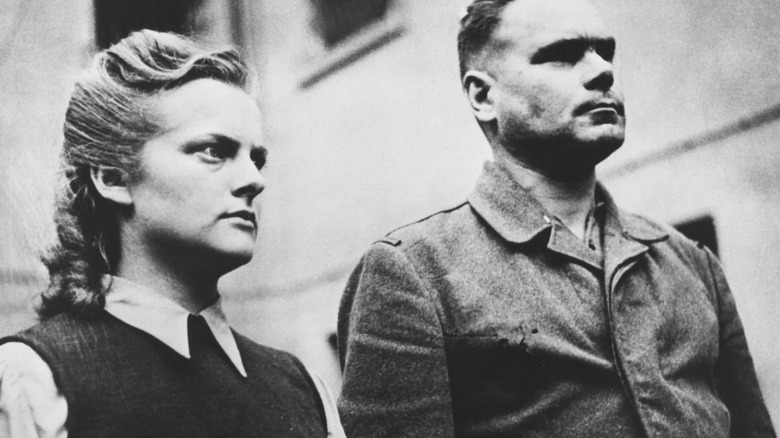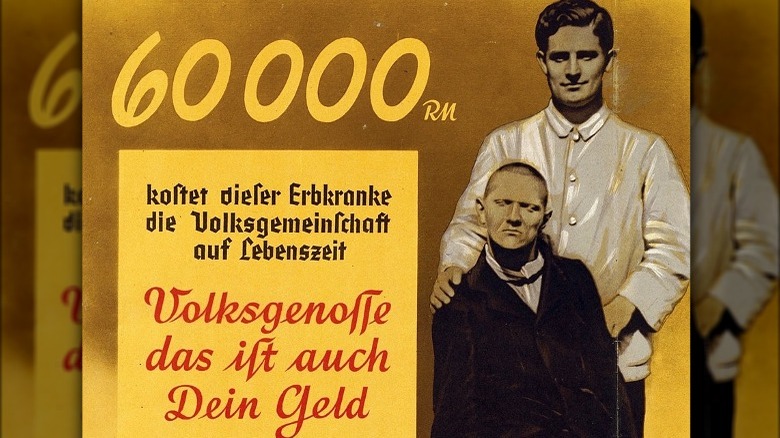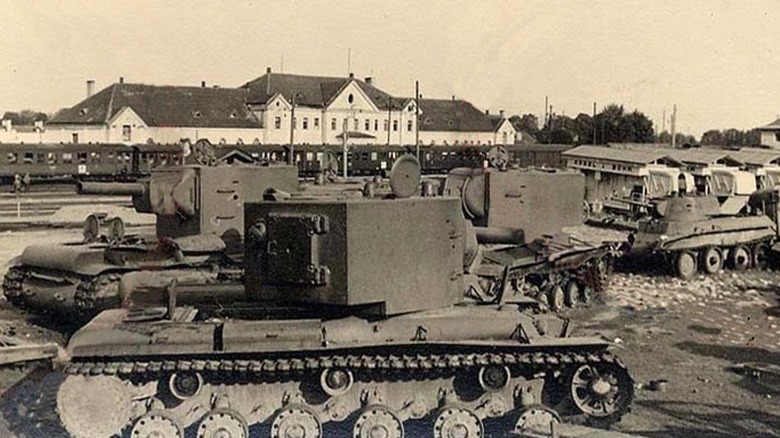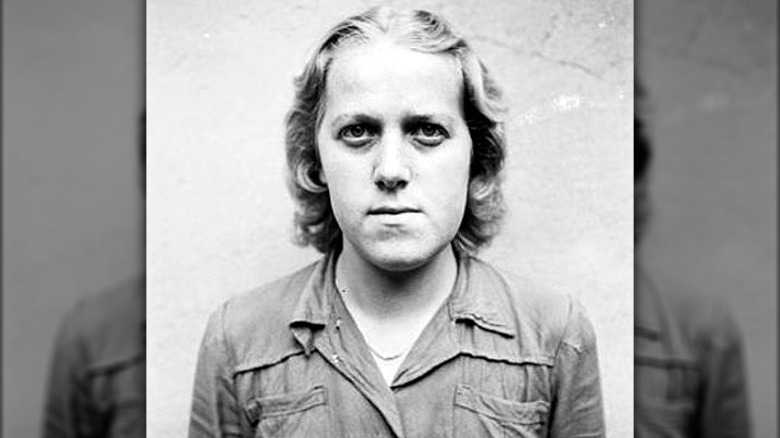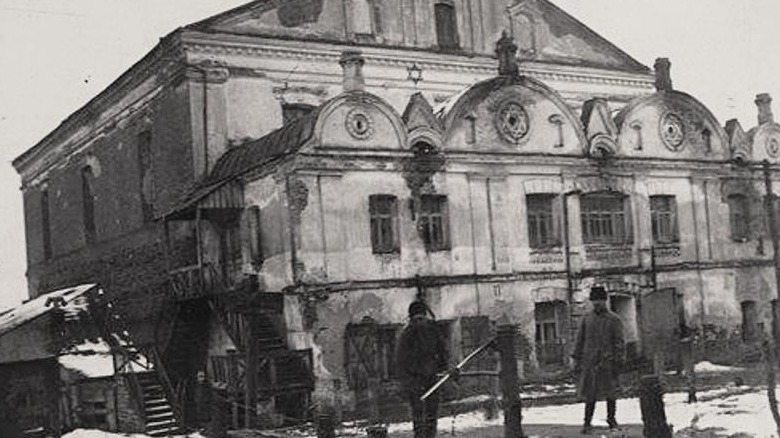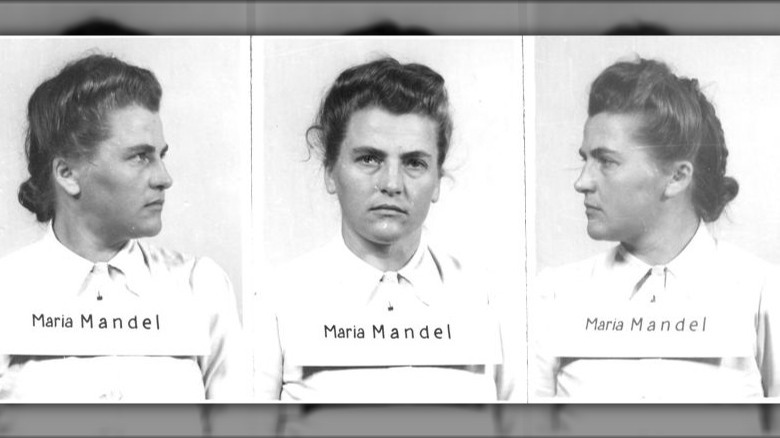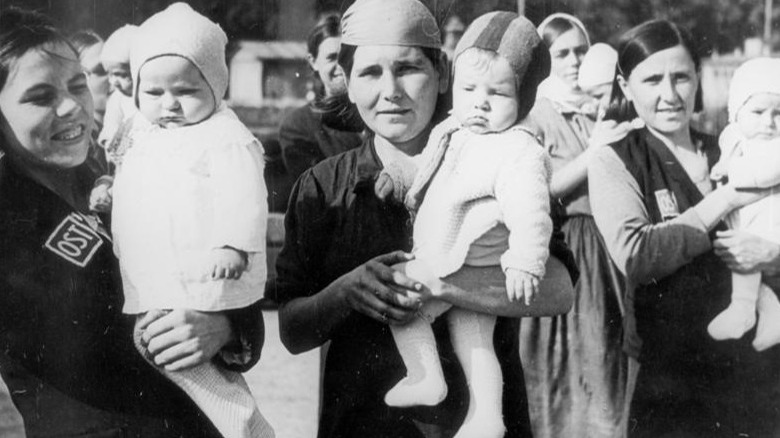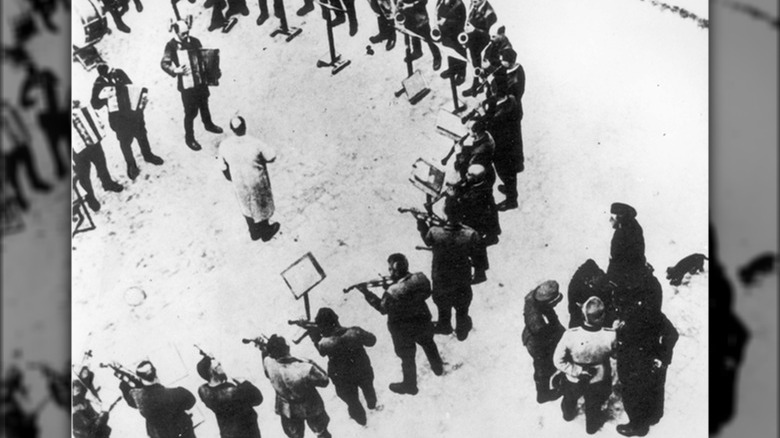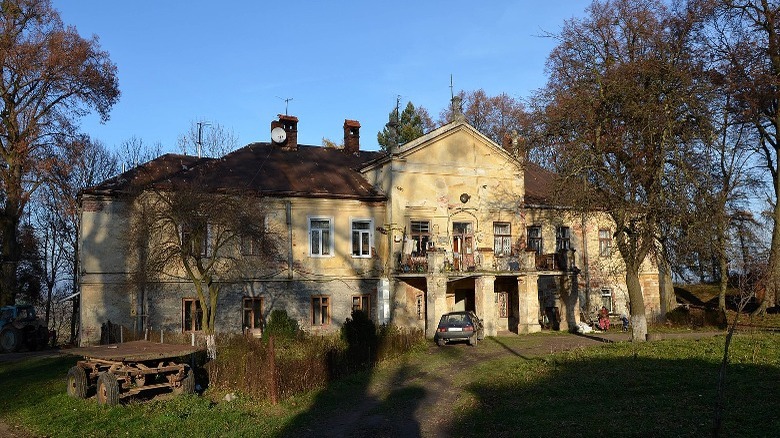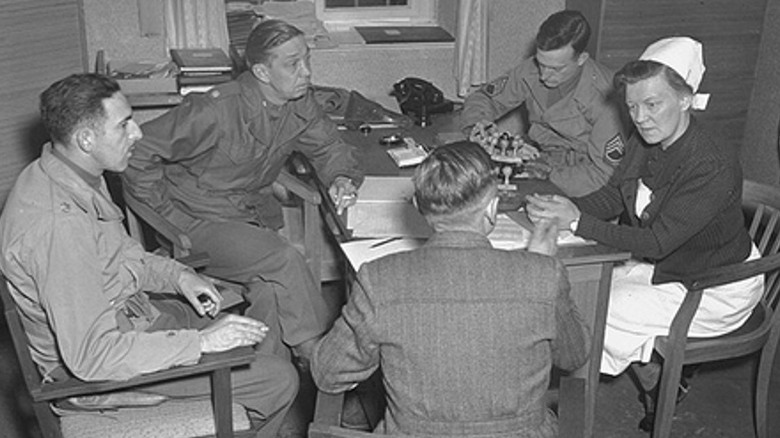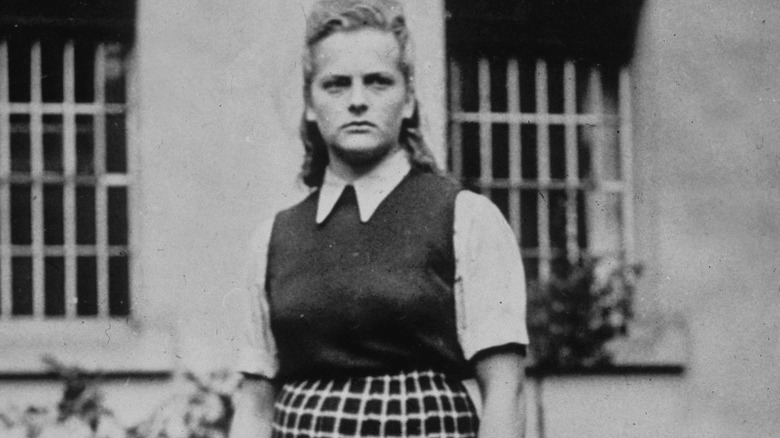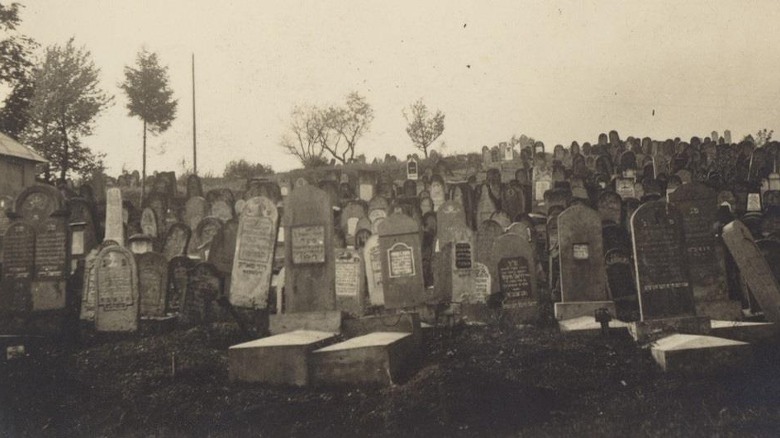The Disturbing History Of The Killer Women Under Hitler's Regime
The role of women in the Third Reich is a fascinating one. On one hand, they were famously celebrated for their role as child-bearers: Blonde-haired, blue-eyed women were the progenitors of Hitler's ideal Aryan race, and even as they were tasked with bearing children, they were also relied on to be teachers, passing down Nazi doctrine to future generations.
But that's not all they were. Research has shown that a shocking number of women filled other, bloodier positions, and carried out Hitler's vision in ways other than just multiplying and reinforcing his racial ideals.
Historian, academic, and author Wendy Lower spearheaded extensive research into the role of the Nazi regime's women and found some shocking things — starting with the fact that the full extent of their participation in the so-called Final Solution will likely never be understood. She explained to The Jewish Chronicle: "[T]housands ... would have had some role in the Holocaust, whether as secretaries administrating the mass murder or in a more direct form. Because of the lack of documentation, it's hard to calculate figures. But, we did some statistical analysis and the probability is that [one woman] could be multiplied a thousand times." That said, let's look at some of the roles women played in the widespread slaughter that swept across World War II Europe ... and some of the women who did the killing.
The following article includes depictions of mass violence and hate crimes.
Pauline Kneissler: A nurse in the service of the Third Reich
Nursing isn't just an occupation, it's a calling. The Russian-born but anti-Communist Pauline Kneissler felt that calling from the time she was very young, but she also felt fiercely devoted to her ancestral home: Germany. When the Nazi Party promised a return to the nation's glory days, Kneissler signed on.
According to the United States Holocaust Memorial Museum, Kneissler took on a leadership role among women's organizations within the party, and in 1939, she got the attention of Berlin officials looking for someone to head up the T-4 program. The program began with the killing of infants who were deemed mentally or physically disabled and expanded from there. (Pictured is a poster advertising the cost of supporting a single developmentally disabled individual.) Those who died under the program included the mentally ill, those diagnosed with dementia, and other so-called "undesirables."
Kneissler was brought on board, and her initial role in the operation was to admit patients, prep them for death, and take them to the gas chambers. While doctors were initially tasked with the killing, it wasn't long before Kneissler was transferred to a mental health facility. There, she later confessed, she killed countless patients by overdosing them on drugs like morphine. She was put on trial for hundreds of deaths, convicted, served three and a half years, and went on to work as a nurse in a West German mental health facility before retiring with a full pension.
Liselotte Meier: The secretary that coordinated the executions
The Nazi war machine wasn't just made up of tanks and soldiers. According to historian Wendy Lower's book, "Hitler's Furies: German Women in the Nazi Killing Fields," there were around half a million women who served in various military positions as auxiliary personnel. That included women like Liselotte Meier, who opted for a secretarial job with the new regime.
Meier caught the eye of a man named Hermann Hanweg, and when Hanweg was assigned to the city of Lida (pictured) with orders to exterminate the Jewish presence there, Meier went with him ... and his wife, and his children. What followed was a bizarre scene of mass executions organized, overseen, and attended by both Hanweg and Meier, even as Meier handed out orders to Jewish artisans for special projects, gifts, and home renovations.
Meier became such a trusted confidante that she was given full authority to sign and issue orders on Hanweg's behalf. That included giving overseers permission to execute Jewish workers who showed up late for work. She was the lynchpin, coordinating between executioners, law enforcement, and the pit diggers, but it wasn't all work: She would later admit to taking part in hunting trips where Jewish men were sent into the brush to flush out prey ... and become the hunted themselves. However, when she was put on trial, she would only testify: "I cannot say if the people who were shot were even Jews."
Herta Bothe: Stepping in for the SS
As the conflict dragged on, more and more men of the Third Reich's SS elite were shipped to the front lines, leaving Germany with massive personnel shortages. The answer was — in part — to replace guards in camps like Auschwitz with women who signed on to not only fill critical roles in the vast communications network but to act as guards, too.
According to the BBC, the Third Reich recruited women to work as guards with advertisements luring applicants with "Good wages and free board, accommodation and clothing." Those accommodations were cottages a stone's throw away from the camps, and even as they retired there at night, they sent their dogs after prisoners during the day.
One unnamed guard described it as "the most beautiful time of my life," and in a 1999 interview, Herta Bothe said, "Did I make a mistake? No. The mistake was that it was a concentration camp, but I had to go to it, otherwise, I would have been put into it myself. That was my mistake." Interestingly, though, records suggest that if recruits decided that the beatings and the executions that were a daily part of camp life weren't for them, they could leave. Many — like Bothe — didn't leave: She later acted as an escort on a death march to Bergen-Belsen. After liberation, Bothe was tasked with helping bury the dead at Belsen and complained about it to Allied liberators: Carrying the bodies caused her back to hurt.
Johanna Altvater: It was a job prospect
Not all women who ended up serving the Third Reich found their way there after chasing a fanatical dream. According to research done by Wendy Lower for "Hitler's Furies," some women — like Johanna Altvater — found their niche in the local Hitler Youth movement, knowing it would open doors. It did: Aided by the fact that she fit the profile of the Third Reich's perfect woman, she was welcomed with open arms and sent to Ukraine as a secretary of the Reich Ministry for the Occupied Eastern Territories.
The Jewish ghetto (pictured) had already been established by the time Altvater arrived there with a boss who had a pastime — shooting workers carrying barrels of fuel — that set the tone of the place. Altvater, it turned out, fit right in, and discovered she had a horrible talent: killing children. She appears to have gotten a taste for it after picking up a toddler, smashing the child against a wall, and throwing the body at the father. Every story that follows is just as terrible: She was known to pluck children from their hospital beds and hurl them from third-floor windows, and shoot others in the face when they asked for food.
In the World War II aftermath, Altvater was put on trial, proclaimed that she had only been a lowly secretary, and was ultimately acquitted in spite of the testimony of dozens of people who described the brutal murders they'd see her commit.
Maria Mandl: The orchestra-leader of Birkenau
In 1947, Sala Feder testified against Maria Mandl, the notorious head of Birkenau (via the Institute of National Remembrance). It's heartbreaking stuff: According to Feder, Mandl relished her role in overseeing the arrivals of new prisoners, deciding who was going to the camps and who was going straight to the crematorium ... and estimates suggest about 90% of arrivals were executed immediately.
Feder described what happened to one woman who arrived with her in graphic detail. After Mandl dragged her 2-year-old toddler from her arms and tossed the baby aside, she turned on the mother: "Mandl kicked and beat her so cruelly that she didn't get up any more. She was probably kicked to death, because she didn't give any signs of life and was thus thrown onto a car and taken to the crematorium." Feder continued that when it was her turn, Mandl dragged her 4-year-old away from her and beat her as well, kicking out most of her teeth. Others reached out to help: "I was taken aside and advised to summon all my strength, because otherwise Mandl would send me to the crematorium."
In a bizarre contrast, Mandl was also a huge fan of orchestral music — so much so that according to the Jewish Federation of Cleveland, she petitioned for and received permission to assemble a camp orchestra. Outfitted with instruments seized from prisoners, the orchestra was ordered to play during not only morning roll call, but executions.
Valentina Bilien: Murder at the baby farm
Wartime shortages are well-known but less well-known are some of the ways Nazi Germany tried to combat those shortages. In the spring of 1944, authorities established a facility in Velpke, Germany. The idea was that Polish children would be removed from their parents' care and raised in the baby home, which would free up parents to labor in the fields. The facility and the children moved there were put under the care of a former schoolteacher named Valentina Billien, and over the course of the next six months, somewhere around 80 children died.
Some shocking details unfolded during her 1946 trial. According to documentation recorded in the United Nations War Crimes Commission's "Law-Reports of Trials of War Criminals," Bilien tended to treat the facility as the kind of job where she could just sort of leave for the night. Bilien, on the other hand, testified that she had been short-staffed and underfunded, and when she raised concerns about having enough to feed the children, she was forbidden from doing, well, anything at all.
The building chosen by Heinrich Gerike to house the baby home was described as "a corrugated iron hut, without running water, light, telephone, or facilities for dealing with sickness," which makes it perhaps less surprising that he was ultimately found guilty, sentenced to death, and executed in 1946. For her part in the Velpke home, Billien was sentenced to 15 years (via the Jewish Virtual Library).
[Featured image by German Federal Archives via Wikimedia Commons | Cropped and scaled | CC BY-SA 3.0]
Liesel Willhaus: The Comandant's wife
In some cases, some of the Third Reich's killer women were simply given a platform for their violence.
Liesel Willhaus was married to Gustav Willhaus, the commandant of the Janowska concentration camp (pictured). According to "Hitler's Furies," the once working-class Willhauses relished their new-found status, and at the same time Gustav ruled the camp with an iron fist, Liesel developed her own blood sport. When renovations were carried out on their villa, she insisted on a balcony so she could look down on the Jewish slaves working on their property and shoot whoever she wanted to. Whenever they hosted guests, Liesel became widely known for treating those guests to a show that ended with the deaths of any number of the seemingly limitless slaves sourced from the camps. According to one witness' testimony, "The little daughter of the family, Heike, would vigorously applaud the sight."
She was also said to be fond of shooting camp prisoners as they stood in line for roll call and of executing those who were sick. She was far from the only woman who rejoiced in this grisly target shooting: Gertrude Segel, a Gestapo secretary and beloved of SS Commander Felix Landau, was fond of executing slave laborers who worked in her garden. (It was apparently a match made in hell, as Landau once wrote that he was in charge of so many mass executions that "I hardly got any sleep... Finally I managed to read all my post.")
Erna Petri: The ideal Nazi mother
It's often debated just how much the ordinary German citizen — and even the ordinary soldier — knew about the extent of Hitler's Final Solution, but the story of Erna Petri is an eerie one: Not only was she totally on board with the extermination of the world's Jews, but she was ready, willing, and able to help the cause.
According to "Hitler's Furies," Erna married Horst Petri, an SS soldier who also happened to have a degree in agriculture. Embodying Hitler's idea of the noble farmer fighting for his race and country, Horst and Erna were assigned to live in and work on a plantation in Poland (pictured). They quickly established their own regime on their new estate, handing out beatings, hunting down escaped prisoners who fled through their land, and making regular forays into surrounding villages to find anyone who might be hiding out.
A few months after Horst captured and executed four Jewish prisoners escaping from a train — after telling his dutiful wife that executions were men's work, not women's — Erna was returning from a shopping trip when she came across six children. Dressed in rags and cowering in a ditch, she determined that they had escaped from the nearby train station. She invited them home, fed them, and when her husband didn't return from his own outing, she decided to kill them herself. So she did: She lined them up alongside the estate's mass grave and killed each with a single shot.
[Featured image by Aeou via Wikimedia Commons | Cropped and scaled | CC BY-SA 4.0]
Irmgard Huber: Nurse, executioner
The numbers of people killed during World War II and in the events leading up to it are nothing short of staggering. That includes the 15,000 people executed in just one of the six killing centers operated under the umbrella of the T-4 euthanasia program: When Allied troops moved into Hadamar in 1945, they found a mental health facility outfitted with gas chambers disguised as shower rooms.
Irmgard Huber was Hadamar's head nurse, and shockingly, the Allied tribunals had a bit of trouble charging her with anything. Why? For starters, most of the people who died at Hadamar were German, which meant it was a German matter — not an international one. It wasn't until the names of 476 Polish and Soviet victims were discovered that Huber and her accomplices were put on trial. Don't worry, it gets worse.
Huber was initially released after testimony that she had nothing to do with the deaths and was only re-arrested and tried after it was found that she had not only falsified death records, but selected patients for execution and handed out the drugs used to kill them. By the time she was put on trial, it was 1947, and although she was found guilty, the United States Holocaust Memorial Museum says that she walked free in 1952.
Irma Grese: Terror of the concentration camps
Eric Brown was one of the British soldiers at the liberation of Bergen-Belsen, and when he spoke with ITV at age 96, he said it was a scene that had haunted him his entire life. "The first thing that struck me as you walked in were these mounds of bodies — I'm not exaggerating when I say they were as high as the ceiling." He could still remember the fanatical devotion of the notorious Irma Grese, too. Brown was one of the men who interviewed her: "I asked her four times [whether she had any regrets over her actions] when she suddenly leaped to her feet and with a salute called out at the top of her voice, 'Heil Hitler!' and sat down again."
Eerily, before Grese was trained as a concentration camp guard, she lived a perfectly ordinary life as an employee on a dairy farm (via HistoryToday). When the war was over, the evidence presented at Nuremberg famously revealed the lampshades she had made from the skins of the dead, while witnesses gave testimony about her random cruelty, the dogs she trained to savage prisoners, and the boots she wore to stomp on the dead.
Grese wasn't the only woman renowned for her cruelty. Around 10% of the 37,000 concentration camp guards were women, and although there are stories of kindness — with some witnesses naming guards who would share their food and supplies — those stories are few and far between.
Josephine Block: A wife doing what was needed for her husband
Before she was Josephine Block, she was Josephine Krepp. "Hitler's Furies" says that her name change came with her marriage to an SS officer named Hans Block. One of many devoted SS wives, she joined her husband at his post in Drohobych (pictured) where she acted as an extension of her husband, perfectly comfortable brandishing whips and shouting orders to soldiers. Witnesses recalled her being front and center in ordering the deaths of around 200 people in their town center and demanding the execution of four Jewish girls who had been worked to exhaustion at their local market.
She became so well-known for her violent acts that complaints were actually filed with her husband. He was, perhaps unsurprisingly, not receptive to them, and she continued her reign of terror. Witnesses recalled her running over and killing a child with her own baby carriage, and another incident in which she was approached by a 7-year-old girl begging for help. Block was observed beating her and killing her by stomping on her head.
At the end of the war, Block denied the charges that she had ever killed or beaten the workers that she claimed her husband had simply allowed her to oversee. At her 1949 trial, she claimed that she was being framed by the witness who had testified against her, a Jewish woman who Block said was trying to cover up her own crimes. Block was acquitted.
